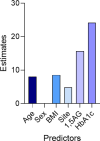Measurement of serum 1,5-AG provides insights for diabetes management and the anti-viral immune response
- PMID: 39912911
- PMCID: PMC11803061
- DOI: 10.1007/s00018-024-05568-7
Measurement of serum 1,5-AG provides insights for diabetes management and the anti-viral immune response
Abstract
Background: Achieving an in-range glycated haemoglobin (HbA1c) is essential for managing diabetes mellitus (DM). However, this parameter provides an estimate of long-term blood glucose control rather than daily glycaemic variations. Glycaemic variability can be more predictive than HbA1c in terms of identifying those at risk for diabetes complications, including risk of severe respiratory virus infections and is usually measured via a continuous glucose monitor (CGM). For individuals for whom a CGM is not available, serum 1,5 anhydroglucitol (1,5-AG) level has shown potential as an alternative method for monitoring glycaemic variability. Despite this, at present 1,5-AG is not routinely used in the clinical assessment of DM. Here, we aim to determine whether assessing 1,5-AG, in addition to HbA1c, is of any potential clinical utility to the management of DM for patients.
Methods: Using machine learning and data derived from 78 patients with type I DM (for whom CGM data is available) we show that the combination of 1,5-AG and HbA1c improves the prediction of a patient's glycemia risk index (GRI) compared to HbA1c alone.
Results: The GRI is an essential tool in the management of DM as it reflects both clinical priorities and patient centred outcomes. The inclusion of 1,5-AG in this prediction was particularly important for individuals who had very high or very low GRI. Furthermore, in the context of glycaemic variability and susceptibility to severe respiratory virus infections, we show that reduced 1,5-AG in the plasma is associated with reduced ex vivo CD4 + T cell cytokine responses to influenza virus in individuals with a matched HbA1c.
Conclusions: Taken together, these data argue for an increased monitoring of 1,5-AG in the clinic for individuals without a CGM to provide additional insights for diabetes management.
Keywords: 1-5-AG; Glycaemic variability; HbA1c; Immune response.
© 2024. The Author(s).
Conflict of interest statement
Declarations. Ethics approval and consent to participate: This study was approved by Mater Research Ethics Committee (HREC/MML/55151 V2) and UQ Ethics Committee (2019/HE002522). All methods were performed in accordance with institutional guidelines and regulations. Written consent was obtained from all study participants. The study was also approved by the ethics committee (CPP Est I, Dijon, France), and each participant gave written informed consent prior to participation. Consent for publication: All authors have approved the final manuscript and consent to publication. Competing interests: The authors declare no competing interests.
Figures







References
-
- Tong MZW, Hulme KD, Law SC et al (2024) High glycaemic variability in individuals with type 1 diabetes is associated with a reduced proportion of CD8 + TNF + cells in response to influenza A virus. medRxiv: 2024.08.27.24311465
MeSH terms
Substances
LinkOut - more resources
Full Text Sources
Medical
Research Materials

